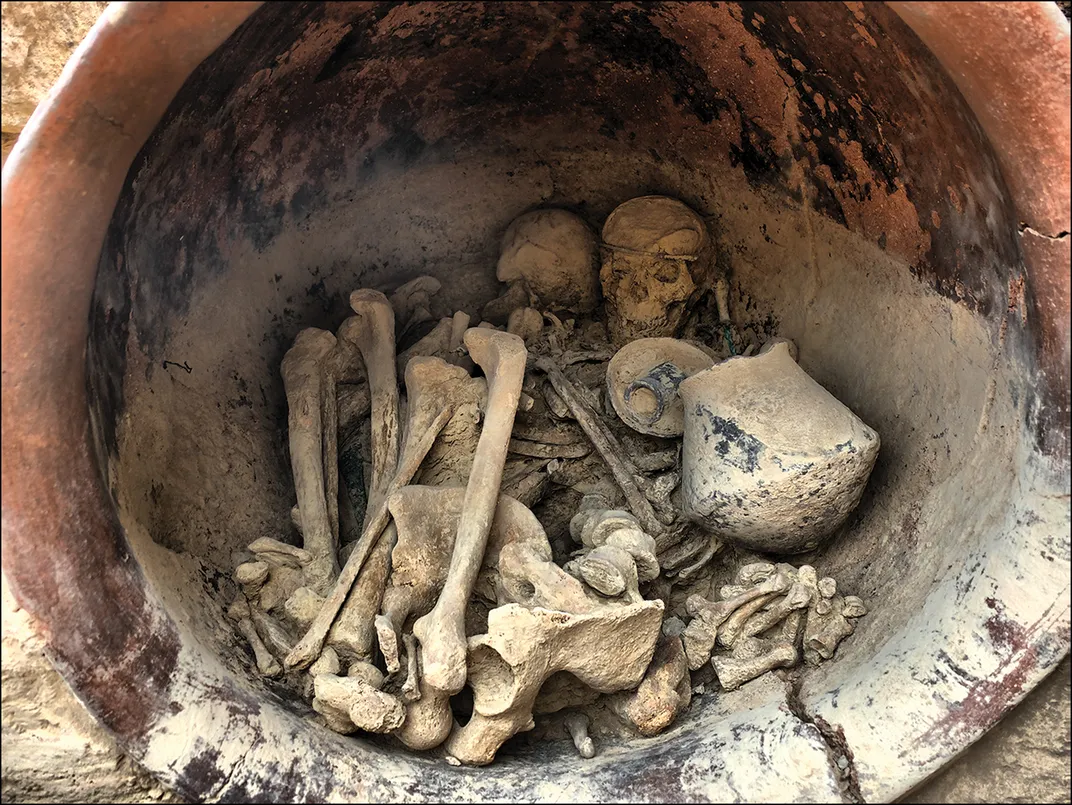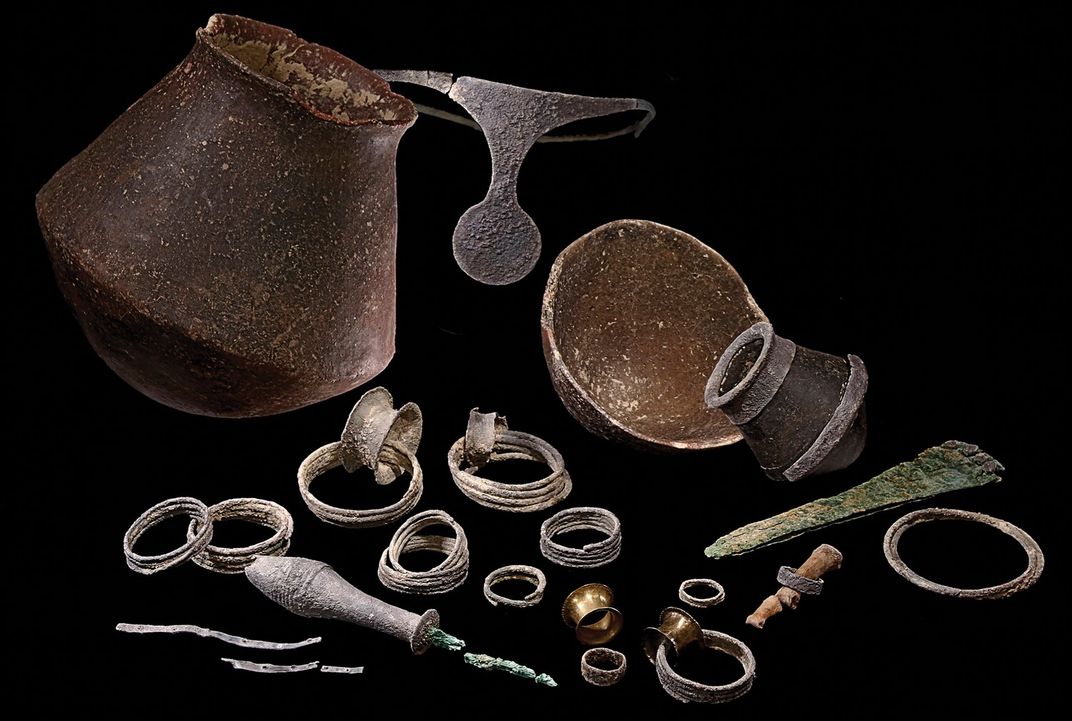Silver Diadem Found in Spain May Point to Bronze Age Woman’s Political Power
Researchers say the crown—and the trove of ornate objects buried alongside it—could have belonged to a female ruler of La Argar
:focal(384x308:385x309)/https://tf-cmsv2-smithsonianmag-media.s3.amazonaws.com/filer/bf/6a/bf6a3d05-88a4-406a-bb77-f72ec8c81411/diadam.jpg)
In 2014, archaeologists unearthed a hoard of ornate objects buried alongside a woman at La Almoloya, a Bronze Age site in southeastern Spain. Now, reports Alberto Quero for Spanish newspaper El País, researchers are theorizing that this unknown woman may have a ruler of El Argar, a class-based civilization that thrived on the Iberian Peninsula between 2200 and 1550 B.C.
Scholars from the Universitat Autònoma de Barcelona (UAB) discovered the 25- to 30-year-old woman’s remains near those of a 35- to 40-year-old man who could have been her consort. As the researchers write in the journal Antiquity, radiocarbon dating suggests that the couple was buried around the mid-17th century B.C., at the height of the Argar society’s development.
Per a statement, the woman was interred with around 30 valuable artifacts, including a silver diadem (or crown), vessels containing animal offerings, and jewelry.
“We have two ways of interpreting this,” co-author Roberto Risch tells National Geographic’s Tom Metcalfe. “Either you say, it’s just the wife of the king; or you say, no, she’s a political personality by herself.”
The La Almoloya tomb seems to support the latter theory. Nearly all of its contents belonged to the woman, and as Ashifa Kassam notes for the Guardian, these objects were of the highest quality: In total, the hoard contained 230 grams of silver—a sum equal to 938 daily wages at the time, or 7,385 pounds of barley. Other highlights of the find include bracelets, rings, earlobe plugs, a dagger, layered necklace beads, textiles and pottery.
For the study, researchers compared the diadem to four others found in elite Argaric women’s tombs.
“The singularity of these diadems is extraordinary,” says co-author Cristina Rihuete in the statement. “They were symbolic objects made for these women, thus transforming them into emblematic subjects of the dominant ruling class. Each piece is unique, comparable to funerary objects pertaining to the ruling class of other regions.”
According to New Scientist’s Michael Marshall, scholars are unsure whether the four other women buried with diadems were religious or political figures. But the fact that the La Almoloya crown was found in what is believed to be a government building lends weight to the theory that these women wielded significant power.
“The role of women in the past was much more important than we have dared to imagine,” Rihuete tells CNN’s Jack Guy. “This says a lot about the process of silencing that women have suffered since.”
Most men in El Argar, meanwhile, probably served as soldiers. Per the statement, male tombs associated with the civilization contain swords and other weapons—and, crucially, are far less elaborate than those of their female counterparts.
Wear on the La Almoloya man’s bones further support the idea that he was a warrior, suggesting that he spent a significant amount of time on horseback and sustained at least one major injury, write the authors in the study.
/https://tf-cmsv2-smithsonianmag-media.s3.amazonaws.com/filer/29/6a/296a97af-b8e3-4b8c-9e4a-149bb65d295e/urn_cambridgeorg_id_binary_20210306123405668-0041_s0003598x21000089_s0003598x21000089_fig2.png)
Archaeologists’ knowledge of El Argar is limited. But they do know that during the last two centuries of its existence, the civilization became the first state organization in the Mediterranean, developing a rigid social structure and a nobility that relied on a tax system, according to the Guardian. By the 16th century B.C., El Argar’s inhabitants had left the area, probably as a result of internal revolts.
“Shortly after the woman dies, the whole settlement is burned down,” Risch tells the Guardian. “And not until the Greeks and Phoenicians arrive on the Iberian Peninsula did we see anything similar, either in architecture or in political dimension.”
Some researchers have expressed skepticism regarding the team’s findings. As Luis Benítez de Lugo, an archaeologist at the Universidad Autónoma de Madrid, tells El País, per Google Translate, the study raises lines of inquiry that “cannot be ignored” but remains speculative, with little concrete evidence linking the rich funerary artifacts to their owner’s political heft.
Speaking with National Geographic, anthropologist Antonio Gilman says that the structure at La Almoloya was far less developed than other Early Bronze Age edifices in Eastern Europe, including the Minoan palace of Knossos on Crete.
Still, Gilman adds, “that doesn’t take away from the fact that these are very important finds.”
/https://tf-cmsv2-smithsonianmag-media.s3.amazonaws.com/accounts/headshot/Isis_Davis-Marks_thumbnail.png)


/https://tf-cmsv2-smithsonianmag-media.s3.amazonaws.com/accounts/headshot/Isis_Davis-Marks_thumbnail.png)